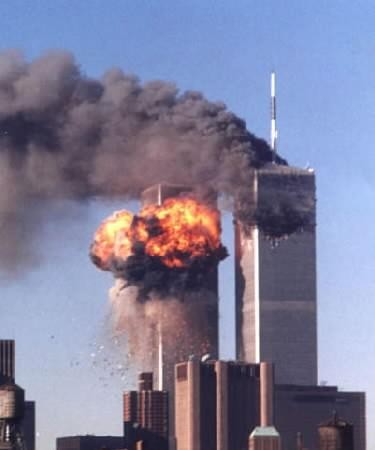by the Retort Collective based in the Bay Area of San Fransisco.
A collective effort they use Situationist theory of the Spectacle to analyze the current Bush phony war on Terror.
In light of the Pentagon release of Al-Qaeda materials this weekend that show Osama bin Laden understood the importance of media imaging of his war on the U.S. especially the attack on 9/11. It was the unreal reality of TV imaging, that then created the market response of 'reality' TV.
Retorts analysis of this as a Spectacular War, a media war fought in images and through media including the internet, becomes important for the Anti-War movement and the Left to understand.
They also use the theory that the permanent war economy that the US has embraced is a form of primitive accumulation of capital, which is also discussed in an earlier article in NLR.
It is this analysis that I have also posited here, that capitalism as globalization still requires primitive accumulation of capital, war zones with the consequential piracy and brigandism that marks the earliest form of capital accumulation.
Julian Stallabrass: Spectacle and Terror
The central claim of the book is that, with the attacks of 9-11, the us state was wounded at the level of the spectacle and cannot endure this ‘image death’ or ‘image defeat.
The perpetrators were fully conscious of what they were about, were in fact Debordian in their thinking, reasoning that capitalism is dependent on the colonized social circuits that comprise spectacle—including confidence in the market and the state, and an identification with commodity culture—and that to disrupt spectacle may have great and unpredictable consequences. The attacks, Retort claim, were not atavistic pinpricks but modern politics, an assault above all on the ‘ghost sociality’ purveyed by the media The assault on spectacle, not on economic power or even people, was their main business, and in this sense they were for a short time remarkably successful.
There is much that can be said to qualify this view. The motivations of the bombers themselves may never be known, although Retort point to tracts on media theory found in Al Qaeda camps. They must indeed have known that the consequences of their acts could not have been accurately predicted, and this makes their political motives—as opposed to their religious ones, or the desire for just revenge—murkier still. Retort are correct that the void at the level of the image in the mainstream broadcast media was remarkable
In any case, it may be that the point of terror is not merely to disrupt spectacle by producing indigestible images, but to exceed it. Retort highlight the paradox of the vanguard Islamic revolutionaries, who deny themselves all that capitalist spectacle has to offer, and harden themselves against mundane sentiment and appetite, yet who still hold to the effectiveness of the image, and propagate images of their acts through websites. Just as in their lives and deaths they seek the unmediated, so their atrocities perform it, being designed to produce real, bodily fear (not the sublime of air shows), to blanket a city with the smell of fire and blood, to bring to a people sunk in spectacle the ineluctability of arbitrary death. The July 2005 London underground bombings were not meant primarily to create images, but to spread the terror of living burial among the city’s populace.Retort argue that the result of the spectacular defeat of 9-11 has been to push the state into actions that are as much governed by spectacle as by material considerations. Warfare has been elevated from an intermittent action to permanent imperial conflict. They claim that one frequently repeated charge of the anti-war movement—that the war was fought for oil—when taken too simply, ignores the ‘partially non-factual imperatives of capital accumulation. These include the effort to repair spectacle, and the drive to normalize war in the minds of citizens.
Retort are surely correct to point to the state’s efforts to create images that can counter the memory of 9-11, and to their insufficiency: Bush on the flight-deck proclaiming victory in Iraq, Saddam’s statue toppled, the dictator captured, the SmokinÂ’ Marine who was supposed to embody the cool courage of the us armed forces, and so on. It is not that these were ineffective pieces of propaganda, but they have subsequently soured as the war and acts of terror have continued. The most memorable images so far gathered by the us armed forces in Iraq are those taken on the phone-cameras of the torturers of Abu Ghraib. Similarly, us political support for Israel is seen as no longer being driven by strategic or military considerations, which now would operate against such an alliance, but rather as an attachment at the level of the image: both are simultaneously democratic consumer societies and highly militarized states with a pioneer ethos, and both harbour the guilt and pride of having taken their land by expelling and exterminating another population. The us in seeing Israel looks into a mirror and cannot abandon its own reflected image.

Find blog posts, photos, events and more off-site about:
NLR, Retort, Osama, bin, Laden, Al-Qaeda, Spectacle, Debord, Situationist, War, Bush, 9/11, Iraq, Afghanistan, Terrorism,
No comments:
Post a Comment